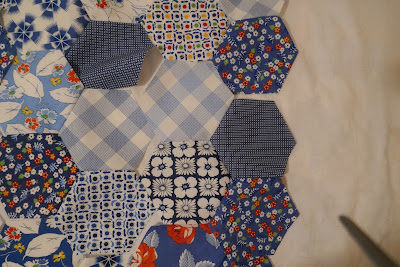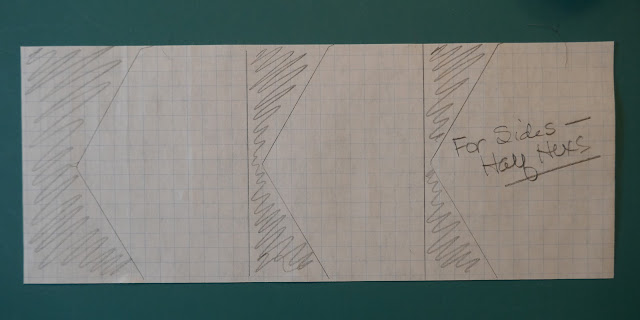The blue hexagon quilt is not ready to layer up and quilt because apparently, one of my retirement goals is to start as many projects as possible concurrently?!?
Not really, but I do have more "oars out of the boat" right now than might be a good idea.
I did make good progress and am certain (?) I'll have it ready to quilt next week.
There have been a few little hiccups as I discover two of the same print setting next to each other (the work of gremlins in the night), not just once, and if it bothers me now, it will always bother me.
So taking a deep breath and fixing them.
Since I don't have any extra hexagons, it means I have to switch each one with a hexagon in another part of the quilt top. Since I haven't joined all the units at this point, it is less work than it could be. Because many of the seams are on the bias, I snip every fourth or fifth stitch . . . . .
. . . . . flip it over and pull on the bobbin thread to remove all the stitches without stretching the edge. One thing I have learned -- always do this "stitch-clipping" with the hexagon being removed on top!
If I don't do that, I sometimes undo the wrong seam.
Grrrrr.
Two hexagons out, switched and ready to stitch back in place!
I've been in the studio quite a bit and am keeping up with my #100days100blocks blocks -- I pieced the 85th one today while switching the hexagons!
I tidied up the fabrics I'm using that have been living on the floor for the past 85 days
and cut the next few days blocks this morning while waiting for my morning tea to kick my brain into gear. Ahhh, the zen of rotary cutting!!
The quilt is looking great and I've started to stitch some of the blocks together into groups of four.
If you go onto my Instagram feed (@hueymary), you'll see some pretty cute hedgehog peek-a-boo happening!
During the past week, I also accomplished my #onemonthlygoal for September by assembling the upper left corner of my current masterpiece using Marge Sampson George's Dodecagon blocks.
Just two more corners to assemble! My traveling stitching box is full of green, yellow, and pink basted hexagons to assemble into the various units needed for the next corner.
I'm continuing to assemble these large English paper pieced tiles from the #sharksdinnerBOM -- nine are ready for the background and I should finish basting the last few pieces for the tenth one this evening to assemble by the end of the month!
The challenge I set myself (using Kaffe collective fabrics with my stash) may be the undoing of me with this project as there's not as much cohesiveness as I'd had hoped. The blocks are terrific individually but I may have either two quilts (a warm color palette and a cool color palette) or twelve large pillow covers if I can't resolve my frustration with the color palette as I add the background fabrics.
I will say that my EPP skills have improved as a result of this project!!
And @lemonshark is a very creative designer!!
Because all that isn't enough to have going on -- this week, I started the #littlemisssawtoothqal!?!
I didn't have to leave the studio to find the fabrics and I have a purpose for the finished quilt.
Surely that is enough justification??
The layer cake I'm using has been on my shelves for at least three years (along with 1 1/2 yards of the polka dot background). Plus my youngest grandson will need a big boy bed quilt (in a couple years) and his middle name is Fox and early indications are that might be his moniker, so . . . . . I'm good, right?!?
So this morning's tea worked and it's been a good day!!
A morning in the studio followed by a tidy up in my office (even washed windows and changed the valances) and still hand stitching to look forward to this evening!!
I think I might go for a walk just in case I crash and burn tomorrow.
Mary






























































